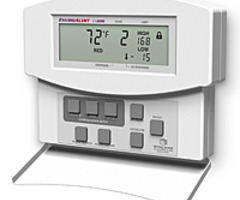Temperature Sensors





Almost every modern building has a heating and cooling system that keeps the building at a reasonable temperature at all times. But in the event that these devices fail, it can result in some serious problems. For example, in the months, a failed heater can result in more than just an uncomfortable house. In the event that the temperatures inside the home fall low enough, it could cause the pipes to freeze. If this were to happen, it could result in thousands of dollars worth of damage, this can be prevented with the use of a simple temperature sensor inside. That alone makes a temperature sensor a very useful investment for a building.
A temperature sensor can also work the other way around. If it’s the summer months and a cooling system fails, this could cause some problems as well. People with certain medical conditions who cannot tolerate high temperatures can have their lives saved thanks to a temperature sensor. Also users who maintain a wine cellar might use a temperature to prevent their wine from being destroyed due to high temperatures. And of course, many users might simply want a temperature sensor to warn them before they return home to an uncomfortable hot house.
The temperatures at which a temperature sensor will activate tend to vary between different devices. In any case, a temperature sensor will activate when such a temperature has been detected continuously for a few minutes. These devices will typically not activate immediately upon sensing an extreme temperature in order to prevent false alarms. But if the temperature is continuously present for a few minutes, then that means something is wrong, and the sensor must alert the system to the situation. When this happens, the sensor will sent a signal to the alarm system so that the programmed response can be performed by the alarm system.
Temperature sensors should not be confused with heat sensors. A heat sensor is a life-safety device that responds to unusually high temperatures associated with a fire. These are serious temperatures that wouldn’t be caused by a broken AC unit, but rather by a very dangerous and life-threatening situation. A dedicated temperature sensor on the other hand, will activate upon sensing a much lower temperature. For example, a heat sensor might activate after sensing a temperature above 135 degrees Fahrenheit, while a temperature sensor might after sensing a temperature above 95 degrees Fahrenheit. That makes for two very different device types.
Often, a temperature can be programmed to a different Loop Number in order to change the temperature at it will activate. We recommend checking with the user manual for the device to determine the perfect loop number. Additionally, a temperature sensor can be either wireless or hardwired to the alarm system. Each type has its own set of advantages and disadvantages before a user makes their purchasing decision. Remember, a wireless temperature sensor will be easier to set up initially, but a hardwired sensor will never require any battery replacement.





